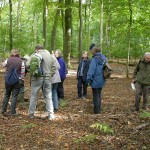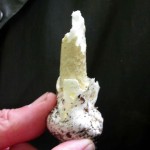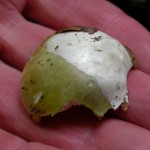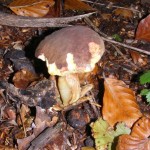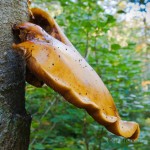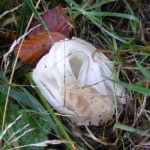Europe’s most poisonous fungus, the Death Cap, was the one of the highlights of the fungus foray which Gordon Crutchfield led at New Copse, Gallowstree Common on Sunday 14th October. It has a smooth greenish cap and its swollen base is encased in a white bag or ‘volva’. Fortunately this is a rare fungus, because if consumed, its toxins destroy cells in the liver and kidneys and it is usually lethal. The Death Cap was spotted close to the path and Gordon picked it up for closer inspection, at which point the cap broke off the stem. It is to be hoped that he washed his hands carefully before eating supper.
Heavy rain in the preceding days had contributed to a bountiful selection of fungi in the woods. Two different sorts of puff-ball were identified – the Common Puff-Ball Lycoperdon perlatum growing on soil, and the pear-shaped L. pyriforme on dead wood. Butter Cap, with a greasy-feeling cap, was plentiful near the entrance to the woods. Mycena croccata is a Chilterns speciality. Its stem exudes an orange-staining liquid and it was growing under beech. Other finds under the beech trees included purple Amethyst Deceivers, the white fingers of Stag’s Horn, Red-cracked Boletus, Common Yellow Russula and the Glistening Ink Cap. A large yellow slug looked like a fallen leaf. On the edge of a grassy ride junction were a number of tall Parasol Mushrooms, with an obvious ring and a snakeskin pattern on the stem. Gymnopilus junonius is a tawny coloured gill fungus which normally grows at the base of trees. A surprise find was a specimen growing 2 metres up the trunk of a beech tree, masquerading as a bracket fungus. On the walk back, a number of twisted specimens of Elfin Saddle Helvella crispa were found in the grass at the side of the ride and a single red Fly Agaric was growing under birch.
Pictures by Rob Stallard, Dave Dare and Jan Haseler

